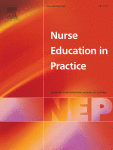
Innovating handoff communication training: A scoping review
Health education is undergoing a profound transformation. This change is driven by the need to develop competencies that respond to the complex challenges of healthcare delivery at both global and local levels. It is also motivated by the imperative to renew traditional pedagogical strategies and by the rapid advancement of emerging technologies such as artificial intelligence (Lin et al., 2024, Profuturo & OEI, 2023, Rincón et al., 2025, Simms, 2025). This transformation calls for the integration of digital technologies as a key resource in developing innovative pedagogical designs that foster meaningful learning among health students and professionals (Bhuttah et al., 2024, El Arab et al., 2025, Oliveira Silva et al., 2025).
In this context, communication competencies, such as those mobilised during clinical handover, emerge as a critical and emblematic area of current pedagogical challenges, particularly regarding their effective teaching in both academic and clinical settings. (Bøje and Ludvigsen, 2020, Shahian, 2021, Vanderzwan et al., 2024)
Innovative educational experiences in health have shown a strong impact on teaching and learning. Active methodologies improve critical thinking and the integration of theory and practice (Bhuttah et al., 2024, Oliveira Silva et al., 2025, Quek et al., 2024, Santos et al., 2019). Emerging technologies, including artificial intelligence and virtual reality, further enhance complex cognitive skills, autonomous learning and confidence in clinical contexts (Bozkurt et al., 2025, Lin et al., 2024, Ma et al., 2025). Together, these approaches foster interactive, personalised and contextually relevant learning environments, optimising learning when coherently aligned with objectives and learners’ needs (Asal et al., 2025, Bartolomé et al., 2024, Simms, 2025).
Within the ongoing educational transformation, strengthening clinical communication has become a cross-cutting priority in healthcare training. It is recognised as a core professional competency by academic institutions and international organisations (AACN, 2021, Agency for Healthcare Research and Quality, 2023, QSEN, 2020). In particular, handover communication—the transfer of information and responsibility between professionals within the same discipline—is the most frequent and vulnerable process in healthcare delivery (Shahian, 2021). The Joint Commission has repeatedly identified communication failures during handoffs as a major contributing factor to sentinel events, emphasising that effective handoff communication is both a professional competency and an essential component of patient safety (JCI, 2015, JCI, 2017, JCI, 2025). Strengthening this process is crucial to preventing adverse events (Ahn et al., 2021, Bukoh and Siah, 2019, Desmedt et al., 2021, Starmer et al., 2014). Despite broad consensus, handoffs remain fragmented and inconsistently structured and are still considered an underdeveloped skill (Reed et al., 2020, Song and McCreary, 2020, Turner et al., 2021). Moreover, handover performance reflects clinicians’ reasoning and decision-making quality, linking communication with clinical judgement (Altabbaa et al., 2024, Chan et al., 2023).
Given this, it is essential to design educational interventions adapted to different contexts to promote safe, structured and efficient communication and to strengthen a shared mental model within healthcare teams (Shahian, 2021, Starmer et al., 2023, Vanderzwan et al., 2024). To date, their implementation has been heterogeneous and has achieved limited results (Bøje & Ludvigsen, 2020). Integrating innovative educational approaches—supported by trained educators and systematic evaluation— represents a key opportunity to consolidate their impact sustainably over time and at scale (Bhuttah et al., 2024, El Arab et al., 2025, Lifshits and Rosenberg, 2024, UNESCO, 2023).
In this context, current guidelines on educational innovation highlight opportunities to rethink clinical communication training for healthcare professionals (Kukulska-Hulme et al., 2023, UNESCO, 2023). This field may benefit from integrating active methodologies—such as project-, problem- and case-based learning, performative scenarios and gamification—together with personalised learning and feedback. Emerging technologies, including artificial intelligence and immersive simulation, can further strengthen communication skills when critically aligned with clear educational goals (Forck Lauren, 2023, Kukulska-Hulme et al., 2023, Saab et al., 2021, UNESCO, 2023). Although reviews have examined the use of artificial intelligence in teaching clinical communication (Stamer et al., 2023), none have specifically addressed structured handover training or evaluated its level of educational innovation.
Within this framework, the present scoping review aims to examine the extent to which innovation—both in active methodologies and emerging technologies—has been integrated or adopted to support the development of structured, effective communication during clinical handover, targeting healthcare professionals across all three levels of education (including undergraduate students and practising professionals). The findings will provide an up-to-date overview that facilitates an understanding of the degree of innovation, sustainability and contextual relevance of existing educational interventions.

